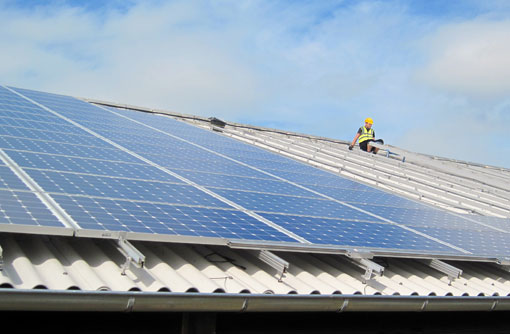Need a new farm building? Consider a solar barn

Strutt & Parker has joined a growing number of companies offering schemes where farmers can invest in a new agricultural building specifically designed to host solar PV on the roof.
The company has teamed up with a preferred building manufacturer and solar panel installer and is looking for farmers interested in investing in a so-called “solar barn”. It says a mono-pitch building of either 50x100ft or 60x80ft provides sufficient roof space for 50kW of solar panels, the maximum size that can qualify for the higher Feed-in Tariff rate.
Total cost and rate of return vary considerably depending on location, site characteristics, finance, tax status, building type and use, S&P consultant Simon Crowe says. But with estimated annual returns of £15,000 from the solar generation and export tariffs, farmers could expect a return on investment of 6-10%, before any value from using the barn on farm or letting the barn to an agricultural tenant is taken into account, he suggests.
Planning is fairly straightforward as agricultural buildings of around this size (up to 5,000sq ft) can be erected under Agricultural Permitted Development Rights, although 28-day notice is required, he says.
Solar barns offer advantages over retrofitting panels on to existing buildings because the whole building is designed with roof-mounted solar in mind from the outset, Mr Crowe says. This avoids possible issues with the integrity of existing roof materials, or orientation and structural strength of the building.
Also, where newer farm buildings are available for a retrofit installation, it is possible that installing solar PV will invalidate warranties on the roofing materials and the structure.
But Mr Crowe urges anyone considering a solar barn not to get carried away by the potential returns from the solar roof alone and to make sure there is a genuine need for a new farm building. “If you do have a genuine need for a new building, whether that’s for storing grain, machinery or livestock, then this is a good way of financing it and is something that lenders have got behind.”
He says that time will be of the essence, as the government’s comprehensive review of FiTs that got under way earlier this year is likely to result in cuts to incentive payments – including smaller-scale solar systems – from next spring. “Realistically you’ll probably need to be making enquiries and getting quotes together by October if you’re going to get buildings built and solar panels connected before the likely reduction in tariffs next April,” Mr Crowe said.
“Typical solar installation costs have fallen significantly, from around £3,000/kW at the start of the year to under £2,350/kW now, which is why the FiT is likely to be reduced.”
• Companies offering solar barns
